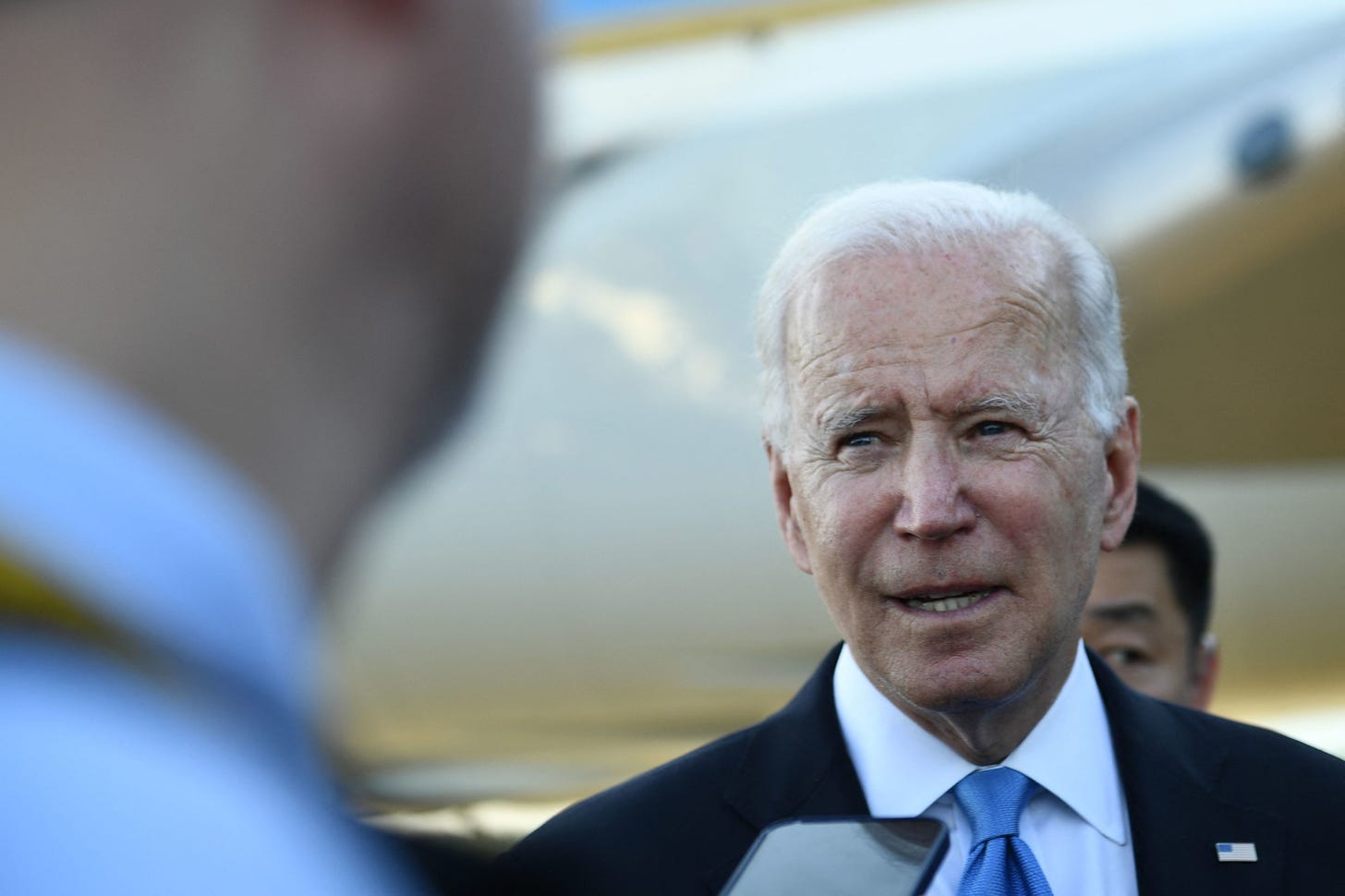Biden's Response to Russian Aggression Can't Rest on Half-Measures
The time to deter a new Russian offensive is before it begins.

It is now difficult for even the most convinced Putinversteher, European or American, to deny that Europe and the United States have a great stake in ensuring that Putin’s war against Ukraine fails. He will not stop if he wins there. After more than a decade of provocations, the Kremlin is now posing the greatest threat to international order and stability since the end of the Cold War. With over 100,000 troops on Ukraine’s border, Putin not only seeks to end Kyiv’s orientation to the West; the draft treaties he proposed to the United States and NATO make clear his intention to imperil all the NATO members who joined since the dissolution of the Soviet Union and to forbid any other country from finding refuge from a revisionist Russia in NATO.
Putin’s current aim is to intimidate the United States, NATO, the EU, and/or Ukraine into making concessions on NATO membership and deployments, EU membership or arrangements with states of the former Soviet Union, and the implementation of the Minsk agreements. He is doing this because his limited, hybrid war in Donbas has failed to stop—in fact, accelerated—Ukraine’s westward political movement.
Putin got away with a major cyberattack on Estonia in 2007, a war of aggression against Georgia in 2008, and the seizure of Crimea in 2014 at little or no cost. Each time, the West’s response was weak. The policy of dismissing Kremlin aggression as a one-off and appeasing Moscow only begot more provocations. This began to change with the Russian military operation in Donbas, and specifically after the shootdown of the civilian airliner MH17 by a Russian BUK missile; the United States and EU imposed sanctions that cost the Russian economy between 1 and 1.5 percent of GDP per year, according to the IMF, and as much as 2.5 to 3 percent a year according to experts Anders Åslund and Maria Snegovaya.
Responding quickly to the Russian buildup this winter, the Biden administration promised three responses to a Kremlin escalation in Ukraine: punishing sanctions, more weapons sales to Ukraine, and strengthening NATO forces in the countries bordering Russia. In other words, a new Russian offensive would not only weaken the Russian economy, but also its geopolitical position along its NATO borders.
This was a good starting bid from Washington, but still weaker than it should have been. If the aim was to deter a new Kremlin invasion, as it clearly was, why not send the additional weapons to Ukraine now, so they would be used to actually deter advancing Russian troops, and why not deploy the additional NATO forces in the east now to complicate Kremlin invasion plans? Only last week, after the Russian troops had been massing for months, did Biden announce that new troops would be deployed to NATO’s eastern flank—but, he qualified, “Not too many.” It took nearly as long for Biden’s team to begin sending additional arms to Ukraine. The trigger for the belated action seems to have beenBiden’s January 19 press conference, in which he seemed to suggest that it would be difficult to sanction Moscow for a “small incursion” into Ukraine.
Biden administration policy was, and apparently remains, conflicted. The administration recognized that a broader war in Ukraine would be a disaster and needed to be stopped; but it also sought and in part may still seek a “stable and predictable” relationship with Moscow. This may explain why Washington has not been fully consistent and robust in dealing with Kremlin provocations. As recently as January 7, Secretary of State Antony Blinken reiterated that “Our goal is to have a relationship with Russia that is predictable and stable.” More importantly, while we are now sending additional arms to Ukraine, we are reportedly not sending many man-portable Stinger anti-aircraft missiles, which would help the Ukrainians diminish Russia’s vast superiority in air power. We have provided no missiles effective against ships or high-altitude aircraft.
Compounding the administration’s confusion is the most peculiar element in the current crisis: friction between Kyiv and Washington. The Biden administration is clearly angry that President Zelensky has publicly contradicted American and allied intelligence assessments about the threat of a Russian offensive, has lobbied Congress to opposition to the Nord Stream 2 pipeline and to support for more arms to Ukraine, and has criticized of the president’s “minor incursion” remarks.
Zelensky’s direct outreach to Congress, where a large bipartisan majority supports Ukraine as it defends itself against Kremlin aggression, is understandable given Ukraine’s \interest in stopping the disastrous Nord Stream 2 project and acquiring more potent weapons to deter a Kremlin escalation. (And both objectives also serve U.S. interests.) But given the importance of his relationship with the White House, he might want to tone down his criticism of the administration and to avoid all criticism of the president himself—especially in public. For its part, the Biden administration might ask itself why, if the Russian threat is so large, it is not expediting the dispatch of the weapons Ukraine so desperately needs.
No doubt some of the inconsistencies in American policy can be traced back to differing perspectives, worldviews, and priorities among the major figures of the Biden administration. This is true of almost any administration, and as in any administration, it is the responsibility of the president to discern who has been right, who has been wrong, and to adjust his policy accordingly.



